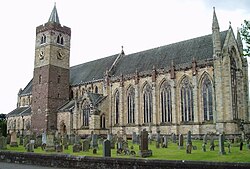Dunblane Cathedral
| Dunblane Cathedral | |
|
Dunblane, Stirlingshire | |
|---|---|
 Dunblane Cathedral | |
| Church of Scotland | |
| Presbytery of Stirling | |
| Location | |
| Location: | 56°11’22"N, 3°57’55"W |
| History | |
| Information | |
Dunblane Cathedral is the larger of the two Church of Scotland parish churches serving Dunblane, in Stirlingshire.
Though it uses the title 'Cathedral' for historic reasons, the church only a parish kirk; it ceased to be a cathedral, which is to say the seat of a bishop with the abolition of that office in the Kirk in 1690

The lower half of the tower is pre-Romanesque from the 11th century, and originally free-standing (like the closely similar example at Muthill), with an upper part added in the 15th century (the change in masonry is very obvious). Most of the rest of the building is Gothic, from the 13th century. The building was restored by Rowand Anderson from 1889–93.[1]
History

The Cathedral was once the seat of the Bishops of Dunblane (also sometimes called 'of Strathearn'), until the abolition of the episcopate after the Glorious Revolution. There are remains of the vaults of the episcopal palace to the south of the cathedral. Technically, it is no longer a cathedral, as there are no bishops in the Church of Scotland, which is a Presbyterian denomination.
William Chisholme (II), the last Roman Bishop of Dunblane in 1561, later became bishop of Vaison in France.
It contains the graves of Margaret Drummond of Stobhall, a mistress of King James IV of Scotland and her two sisters, all said to have been poisoned.
The building is owned by the Crown, and is looked after by Historic Environment Scotland.
The building is largely 13th century in date, though it incorporates an originally free-standing bell-tower of 11th century date on its south side. This tower was increased in height in the 15th century, a change clearly visible in the colour of the stonework, and in the late gothic style of the upper storey's windows.
The choir is unaisled, but has a long vaulted chamber which served as chapter house and sacristy on its north side. The choir contains the mural tomb of the Cathedral's founder, Bishop Clement. Many of the 15th century choir stalls, which have carved misericords (including one with an unusual depiction of a bat) are preserved within the choir. Further, more elaborate, canopied stalls are preserved at the west end of the nave. Dunblane has the largest surviving collection of mediæval Scottish ecclesiastical woodwork after King's College Chapel, Aberdeen. Some other detached fragments are displayed in the town's museum.
Preserved within the arcaded nave are two early Christian stones, a cross-slab and a possible architectural frieze, survivals from an early mediæval church on the same site, founded by or dedicated to the 'Blane' whose name is commemorated in the name of the town.
Dunblane Cathedral Cemetery contains one war grave, that of a gunner in the Royal Marine Artillery during World War I.[2]
The Dunblane Commemoration
In the nave of the Cathedral is a standing stone by the monumental sculptor Richard Kindersley which commemorates the events of 13 March 1996 – the Dunblane Massacre. The quotations on the stone are by E V Rieu ("He called a little child to him..."), Richard Henry Stoddard ("...the spirit of a little child"), Bayard Taylor ("But still I dream that somewhere there must be The spirit of a child that waits for me") and W. H. Auden ("We are linked as children in a circle dancing").
Outside links
- Dunblane Cathedral
- Dunblane Cathedral – Historic Environment Scotland
- Dunblane Cathedral Arts Guild
- Engraving of Dunblane Cathedral by James Fittler in the digitised copy of Scotia Depicta, or the antiquities, castles, public buildings, noblemen and gentlemen's seats, cities, towns and picturesque scenery of Scotland, 1804 – NLS
- Engraving of Dunblane Cathedral in 1693 by John Slezer – NLS
References
- ↑ Dunblane Cathedral
- ↑ [1] CWGC Casualty Record.